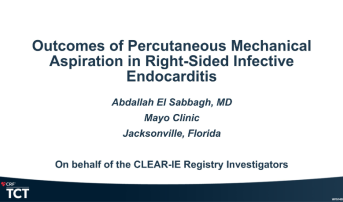Percutaneous Mechanical Aspiration Promising for Right-Heart Infective Endocarditis
The CLEAR-IE registry data, which show clinical efficacy, are just the first step—an RCT may be forthcoming, researchers say.

WASHINGTON, DC—For patients with right-sided infective endocarditis (RSIE) who don’t respond to medical therapy, percutaneous mechanical aspiration (PMA) appears to offer clinical efficacy, according to the multicenter, retrospective CLEAR-IE study. The majority of those treated see their underlying infection cleared, with an accompanying reduction in mortality risk.
“In recent years, there has been a rise in right-sided infective endocarditis,” thanks to increasing numbers of people who inject drugs as well as those who have cardiovascular implantable electronic devices or indwelling catheters, Abdalla El Sabbagh, MD (Mayo Clinic, Jacksonville, FL), said when presenting the CLEAR-IE data at the recent TCT 2024 meeting. “Treatment options for persistent [cases] are limited, with antimicrobials being suboptimal and surgery having high rates of morbidity and mortality.”
Aspiration devices designed for addressing pulmonary embolism increasingly, in recent years, have been an alternative treatment, El Sabbagh told TCTMD. “Using catheters to aspirate vegetations in order to achieve infection source control, just like we do when we drain pus or abscesses, has emerged as a concept,” he explained. In RSIE, the goal with these tools is to debulk vegetation and achieve source control by enhancing microbial use.
CLEAR-IE contributes to the discussion, said El Sabbagh, by providing data on real-world safety and efficacy. “It needed study and data behind it,” he said. “We started with the registry in order to tell us how we’re performing and in order to allow us to then design a clinical trial as a next step.”
El Sabbagh pointed out that PMA is uniquely poised to help this challenging patient population, many of whom are addicted to IV drugs and tend to be lost to follow-up. The treatment can act as a bridge of sorts, he suggested. “Instead of sending them directly to surgery and then discharging them after and running the risk of reinfecting their prosthesis, what we do is we aspirate, we send them to rehab—treat the real underlying cause, which is the addiction—and then proceed to surgery.” The hope is that this multistep strategy lowers the risk of reinfection.
The complexity of infective endocarditis calls for team-based care involving clinicians, imagers, interventionalists, surgeons, addiction medicine specialists, case managers, and others who have the expertise to “tackle the holistic [needs of] these patients,” said El Sabbagh.
Culture Clearance Tied to Lower Mortality
For the CLEAR-IE analysis, researchers looked at 256 patients (median age 43 years; 42.6% female) who underwent right-sided PMA at 19 US centers between January 2014 and January 2024. All had persistent RSIE (large vegetation ≥ 2 cm, persistent blood culture, or recurrent pulmonary embolism) and were deemed ineligible for standard surgery. About 27% had a prior pacemaker and 18% prior endocarditis. Half reported IV drug use, while 12% had a chronic in-dwelling catheter, 6% had active cancer, and 12% were in an immunocompromised state.
For 94.1%, the infection was bacterial, most often Staphylococcus aureus. Patients had been on antibiotics for a median of 8 days at presentation. The median vegetation size prior to PMA was 24 mm, with 69% of cases located on the tricuspid valve.
At baseline, approximately one-third had severe tricuspid regurgitation (TR) and one-quarter had some degree of RV dysfunction. About half presented with septic pulmonary embolism, 35% with hypoxia, 30% with septic shock, and 20% with right-sided heart failure.
Indications for PMA were large vegetation, persistent sepsis, recurrent pulmonary embolism, and an infected lead, at around 75%, 65%, 25%, and 20%, respectively.
Median procedure time was 91 minutes, and 89% of patients were treated under general anesthesia. The most commonly used device was the third-generation AngioVac (72%), while the aspiration catheter access site was evenly split between the internal jugular vein and the femoral vein. Six percent of patients received cerebral embolic protection, El Sabbagh reported. “Although this is a right-sided procedure, this is often to prevent paradoxical embolism in case there was a patent foramen ovale.”
Procedural success, defined as reduction of vegetation size by 70% or to less than 1 cm, was achieved in 89.4%. Sixty-four percent of patients had some degree of residual vegetation (median size 7 mm) after PMA.
The primary efficacy outcome of culture clearance was reached by 92.4%. The primary safety outcome, a composite of in-hospital death, new pulmonary embolism, or emergency surgery, occurred in 18% of patients.
One in 10 patients (9.8%) died in the hospital, which El Sabbagh said aligns with the mortality rates that have been seen previously in this sick population. Rates of new pulmonary embolism, worsening TR, emergency surgery, and vascular access bleeding were 8.3%, 15.7%, 3.1%, and 3.6%. Stroke occurred in 3.1%.
Predictors of culture clearance were having bacteria as the target species (OR 9.71; 95% CI 2.27-38.24), absence of residual vegetation after PMA (OR 4.35; 95% CI 1.18-25), and being in an immunocompetent state (OR 3.33; 95% CI 1.01-10). There were no associations seen for device type, vegetation size at baseline, or location.
Notably, patients with culture clearance had a lower risk of dying in the hospital (OR 0.14; 95% CI 0.05-0.45).
For the primary safety outcome, the predictors included baseline hypoxia (OR 3.62; 95% CI 1.87-7.17), shock (OR 2.27; 95% 1.15-4.43), female sex (OR 2.27; 95% CI 1.19-4.55), RV enlargement (OR 1.98; 95% CI 1.02-3.9), and fewer days on effective antibiotics (OR 0.95; 95% CI 0.89-0.99). No associations were seen for worsening TR or by device type. On multivariate analysis, hypoxia remained the strongest predictor of worse safety.
By 6 weeks after treatment, 7.4% of patients had left against medical advice and 25% had missing data or were lost to follow-up. Among the remaining registry participants, 7.6% died, 8% had their endocarditis recur, 8% were hospitalized for heart failure, 5% underwent cardiac surgery, and 2.7% had a new pulmonary embolus.
“In select patients with right-sided infective endocarditis, the majority of whom were refractory to medical therapy alone, percutaneous mechanical aspiration demonstrated high rates of procedural success and clinical efficacy,” El Sabbagh concluded, adding that PMA had acceptable safety, with adverse events largely driven by the underlying endocarditis.
Importantly, without treatment, these patients who hadn’t responded to other therapies “would die,” he commented to TCTMD. “It’s a very poor prognosis.”
Their registry analysis pertains only to right-sided cases. While PMA can be used for left-sided infective endocarditis, and a substudy of CLEAR-IE in this population is forthcoming, those cases are “a little bit more complicated, because of the stroke risk,” El Sabbagh added.
What Comes Next
Discussant Davide Capodanno, MD, PhD (University of Catania, Italy), thanked the researchers for pursuing a challenging area of investigation that, apart from a few smaller case series, has been a data-free zone. CLEAR-IE will at least “give us some rates that we can discuss with our patients, with relatives, and also with our colleagues when we propose this procedure,” he commented.
US guidelines don’t give any recommendations for PMA in this setting, but European guidelines give it a class IIb, level of evidence C. “So with a study design like that, perhaps we are able to increase the level of evidence from C to B, because this is a relatively large registry for this infrequent condition,” Capodanno suggested, noting that the data cannot be used to change the class of recommendation due to its nonrandomized design and lack of control arm.
Procedural success in the registry was “very positive” considering these patients had no other options, he said. “Knowing you have something to offer on top of something that has failed already is good news for them.” The data were encouraging for efficacy as well, which is especially noteworthy in light of the biologically plausible association between culture clearance and reduced mortality, Capodanno added.
However, he also cited the adverse outcomes that occurred, something that points to room for improvement in patient selection and future devices.
El Sabbagh confirmed to TCTMD that he and other investigators are now discussing the possibility of a randomized trial to follow in CLEAR-IE’s wake. “The process has started,” he said.
Caitlin E. Cox is News Editor of TCTMD and Associate Director, Editorial Content at the Cardiovascular Research Foundation. She produces the…
Read Full BioSources
El Sabbagh A. Outcomes of percutaneous mechanical aspiration of right-sided infective endocarditis. Presented at: TCT 2024. October 30, 2024. Washington, DC.
Disclosures
- El Sabbagh reports no relevant conflicts of interest.







Comments